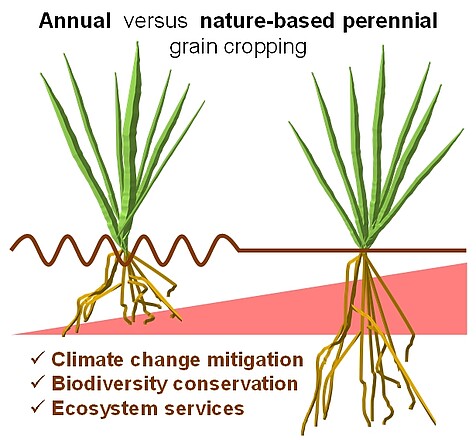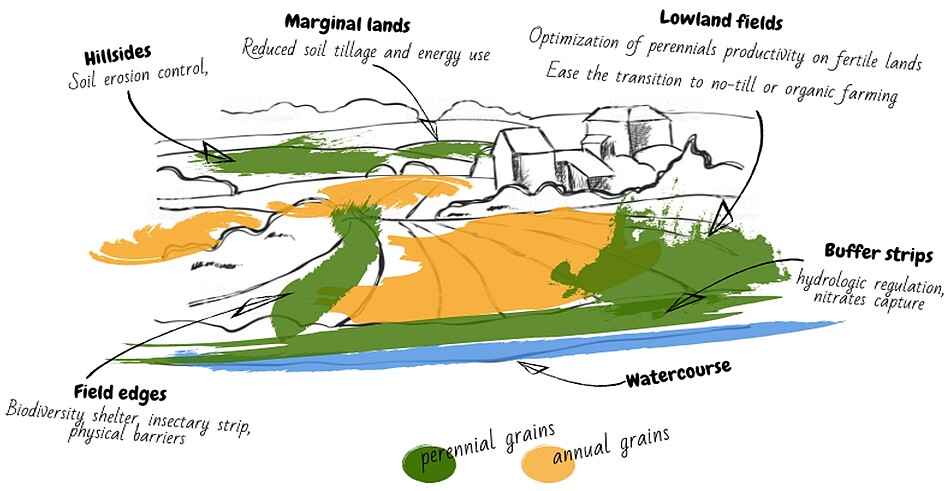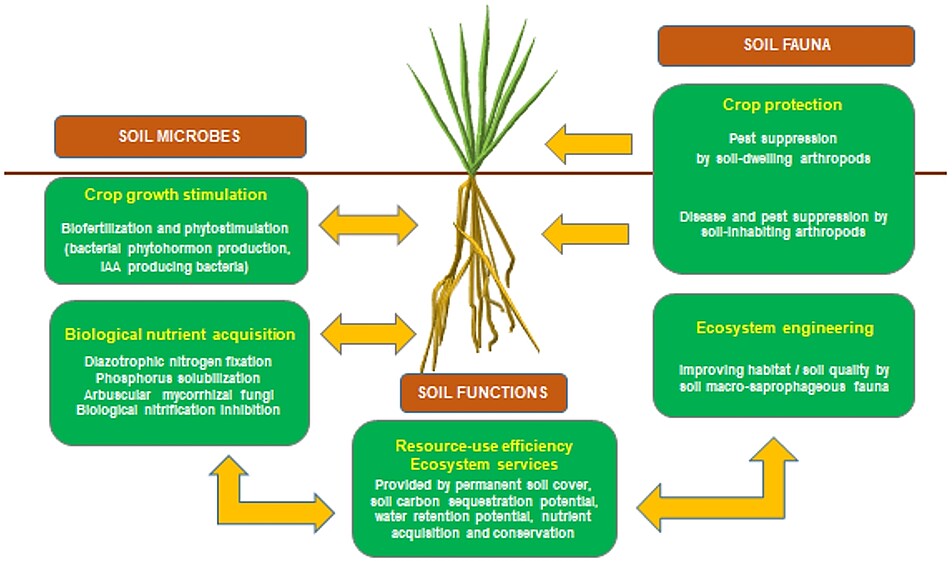Project overview
Problem statement
Agriculture of the 21st century must guarantee food security and bioenergy supply for a growing global population exposed to climate change and degradation of natural resources. Presently, annual crops, including almost all grains, cover most of global croplands and are grown largely under intense management with high inputs of agrochemicals. Due to this, these systems contribute substantially to climate change, environmental degradation and biodiversity loss. Frequent soil tillage and lack of vegetation cover for long periods are associated with extensive soil erosion, soil carbon loss and nutrient leaching, especially nitrogen.
To mitigate the ecological and economic constraints of annual crop production, it will be the global challenge of modern agroecological science and breeding to develop environmentally sustainable and simultaneously high-yielding agroecosystems. Whereas agricultural biotechnology is widely considered as the key component of global food security in future innovative agroecological schemes toward sustainable agroecosystems, potentially integrating novel crops, are hitherto neglected. A concept gaining increasing attention in the area of sustainable agroecosystems is the reversed shift from predominant annual to perennial grain crop production. This agroecosystem shift would warrant high production, while maintaining ecosystem services, functions, and biodiversity.
Solution statement
Perennial grain cropping systems, as inspired by natural grassland ecosystems, provide an excellent design to promote nature-based solutions (NBS) for mitigating global change effects, while maintaining an increased functional agrobiodiversity for a low input food production with social and economic benefits.
The NBS definition includes the use of NBS to provide climate change adaptation and mitigation, as well as innovative planning of multi-purpose agricultural landscapes, including the promotion and protection of functional diversity. The multifunctional concept of NBS has been identified by the European Commission (EC) as a strategic frame to support sustainability.
Thinopyrum intermedium L. (Intermediate Wheatgrass, IWG) is among the most advanced examples of recently domesticated perennial grain crops, but with lower yield compared to annuals such as wheat. To reach outputs similar to annual grains, a domestication program to improve IWG grain yield has been initiated. Developed by the Land Institute (Kansas, USA), Kernza® is the first commercially available IWG in the USA and Canada. Seeds of Kernza® are disseminated for global research before its envisioned registration for commercialisation in 2020 in the US and in timely also in Europe. Kernza® gained interest among farmers in the US and Europe for its ecological and economic benefits. Presently, Kernza is grown commercially by growers throughout the North Central and North Eastern regions of the USA, particularly the Midwest. Demand for Kernza started with the development of Kernza® beer. Market interest has exceeded the supply, as small local and organic artisan bakeries and farm-to-table restaurants turn Kernza grain into breads, crackers and pasta. In addition, dual-use management of Kernza® (both grain and forage harvest) can provide a productive and profitable pathway for perennial grain adoption.
Knowledge gaps
However, besides of these acknowledged benefits of perennial crops, large knowledge gaps exist on the effects of cultivation practices on the long-term productivity of perennial crops and the specific management operations to balance benefits for biodiversity, crop health and productivity as well as for ecosystem services relevant to human health. Because conservation of soil function and biodiversity is inherent to the sustainability and productivity of perennial cropping systems, management strategies for perennial crops depend much more on biological processes and species interactions operating in natural ecosystems than for annual crops. It is yet to be elucidated how plant health-promoting and detrimental organisms and overall biodiversity will develop over years in a perennial cropping system and how to manage effectively relevant system associated functional organisms (Figure 3).
Successful design and management of perennial grain crop production systems requires therefore a systemic ecosystem approach, because management strategies depend greatly on self-regulatory mechanisms of ecological functions and biotic interactions operating in natural ecosystems The exploration (bioprospecting) of such functional traits holds great and innovative bio-economic potential to utilize and propagate selected traits for sustainable intensification of agricultural systems facilitating relevant health aspects related to the crop, biodiversity, ecosystem, and humans.
Research questions
In the EU, the perennial grain concept has not yet fully transformed into research or practical applications and is not yet legitimized by agricultural standards and policies, although they correspond with farmer’s interest in innovative practices and sustainable cropping systems. The development and integration of perennial grain cropping into farming systems in the EU requires a trans-national approach to fill relevant knowledge gaps. These specifically refer to (i) a scientific understanding of the connections between perennial crop production and biodiversity conservation under climate change to facilitate sustainable implementation under different agro-ecological conditions across Europe, and (ii) the improvement of understanding ecological and economic benefits of perennial grain cropping systems among stakeholders (farmers, politicians, general public) to realize perennial grain crops adoption and legitimization along with the creation of value chains.
Accordingly, the main research questions are: (1) To what extent will functional biodiversity and interactions develop over years in a perennial grain cropping system? (2) How will these biotic changes contribute to crop performance, sustainability by reduction of matter and energy inputs, ecosystem service delivery and resilience against environmental change? To answer these scientific questions, the research approach of NAPERDIV is based on comparative analyses between established perennial versus annual grain cropping systems using a Pan-European gradient that allows the evaluation under contrasting agro-ecological and climatic conditions.Accordingly, research is conducted in agronomic research and experimental field sites using Kernza® have been implemented under different agro-ecological conditions across Europe (France, Belgium, Sweden). These will serve as fundament for the integrated research approach of NAPERDIV.
Objectives
The overall objective of NAPERDIV is to establish the base for novel field management guidelines and techniques for identifying best-case scenarios for perennial grain crop use in terms of purposes, growing areas, and coherent farming systems. This will be reached by systematically pursuing the following scientific objectives:
- Analysis of crop performance: Agronomic and environmental performance and resilience of IWG (Kernza®) in relation to resource use capacity to assess and simulate its resilience against climate hazards facing growth conditions that vary in terms of climatic and soil physico-chemical characteristics. The Pan-European gradient will allow the evaluation of varying growth conditions to illustrate potential opportunities and constraints of the performance and agro-ecological adaptability of IWG.
- Characterization of the crop-associated microbiome: Diversity of the crop-associated microbiome, its functional traits (plant nutrient acquisition and disease suppression via production of biostimulants and hormones) and its implications for perennial crop cultivation on plant and agro-ecosystem scale. It also emphasizes the assessment of the microbiome and the genetic signatures of microorganisms associated with IWG in comparison with the microbial functioning in association with annual grain crops.
- In situ climate change simulation: To evaluate the potential effect of expected drought events under field-simulated rain exclusion. Crop performance and the resilience and resistance of the soil microbiome in perennial agroecosystems will reveal climate adaptation and mitigation potential of perennial agroecosystems compared to annual grain cropping systems. Outcomes will provide options for production security and farm-based measures to current climate change challenges.
- Assessment of the biodiversity of the soil-borne and soil-dwelling fauna: Population density analysis of soil faunal engineers, including nematodes and earthworms, and soil-dwelling arthropods (specifically ground and rove beetles as crop pest antagonists). Changes in the activities of these faunal communities, as a result of soil management practices, can be used as indicators of soil and agroecosystem quality. Based on this, an indicator system for soil fauna diversity will be developed to evaluate their functional traits in perennial versus annual grain cropping systems.
- Cropping system modelling: Using data collected from results of previous objectives, this approach will advance and validate existing crop models to simulate the performance and robustness of IWG in the nature-based, perennial grain cropping system in response to various soil and climatic conditions across the EU. This system modelling will improve the understanding of agro-ecosystem functioning by integrating experimental, process-based data and by emphasizing effects of complex biotic interactions.
Moreover, NAPERDIV will increase the awareness of farmers, EC policy, industry, and the general public about the manifold benefits of perennial grain cropping systems to develop NBS that safeguard functional biodiversity towards future-proof agriculture. This outreach of NAPERDIV will be accomplished through:
- Interaction with diverse stakeholders following the concept of the interactive innovation model promoted by the EC.
- issemination of project outputs in an adjusted manner to different recipients at national and international level, and warrant an adequate engagement of stakeholders, emphasizing specifically a strengthening of the science-policy interface.



